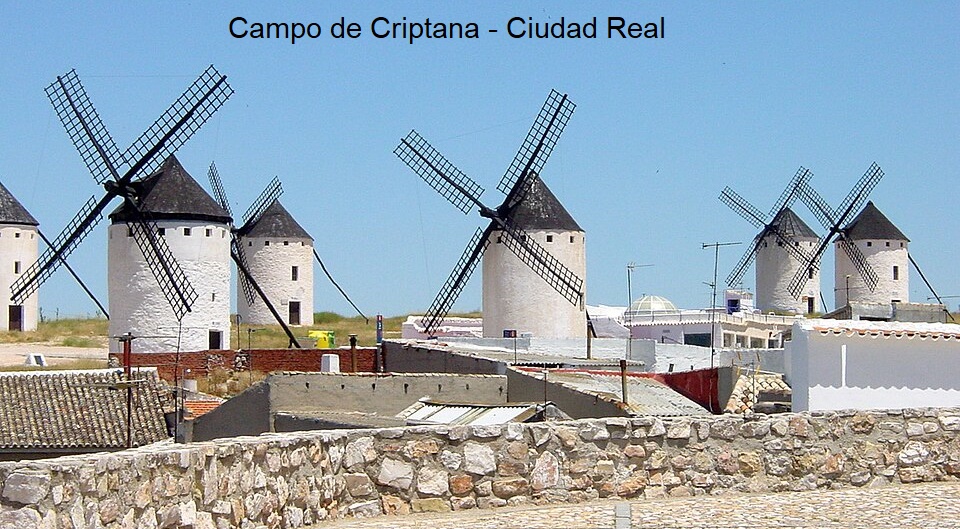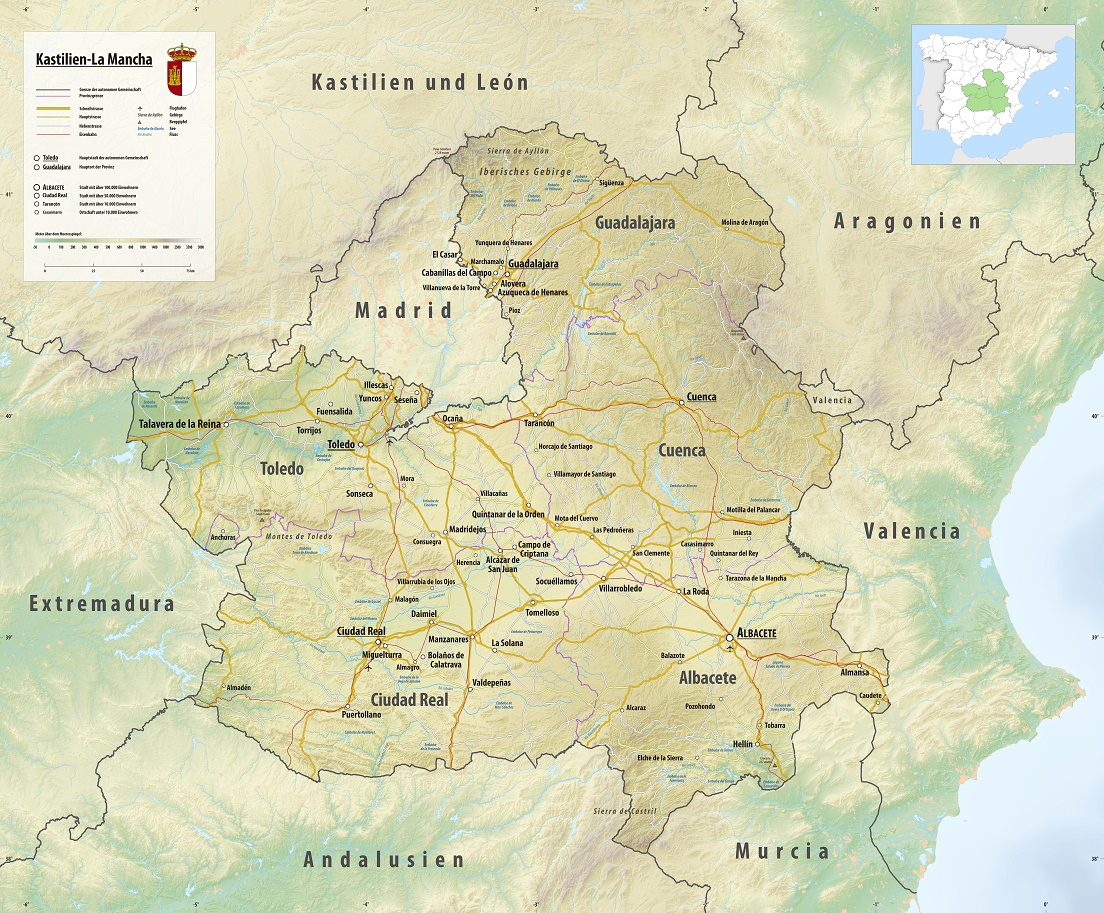Results
2,284 Results
Loading more Results ...
Loading more Results ...
Wine regions in Castilla-La Mancha 27 growing regions
Description to Castilla-La Mancha
Castile-La Mancha (Spanish: Castilla-La Mancha) in Spain is an autonomous community with the capital Toledo and covers 79,463 km². Together with Madrid and most of Castile-León, it forms the region of Castile, whose name goes back to the medieval kingdom of the same name. Castile-La Mancha is the successor to the historic region of New Castile and comprises the five provinces of Albacete, Ciudad Real, Cuenca, Guadalajara and Toledo. The area borders seven regions. Clockwise, these are Madrid to the north-west, Castile-León to the north, Aragon and Valenciana to the east, Murcia to the south-east, Andalusia to the south and Extremadura to the west. Together with Extremadura, Castile-La Mancha is part of the vast Meseta plateau landscape (see map at the bottom).
History
The origins of viticulture can be traced back to the 12th century, when these areas were conquered by the Christian population in the course of the Reconquista (reconquest of the Iberian Peninsula after Muslim conquerors from North Africa had subjugated the Iberian Peninsula in the early 8th century). However, viticulture is said to date back to the Roman era. After the discovery of America in 1492 by Christopher Columbus (1451-1506), the Spanish conquistadores planted vines from their homeland in the colonies of the New World. The Listán Prieto variety from Castilla-La Mancha became the progenitor of many so-called Criolla varieties in Central America and South America under the name Mission. Castile-La Mancha is known for its many windmills and also for the Spanish writer Miguel de Cervantes (1547-1616) and his famous novel "Don Quixote de la Mancha".

Climate & Soils
The extensive plain with its numerous typical windmills has extreme climatic conditions with frosty winters that can drop below 20 °C and hot, very dry summers that often reach temperatures of over 40 °Celsius. The Moorish name "Manxa" (dried land, Spanish for "the spot") describes this very aptly. This is why fungal diseases are almost unknown. On average, there are more than eight hours of sunshine a day, 365 days a year. The average annual rainfall is very low at just 300 to 400 mm. Large parts of the area are characterised by calcareous, nutrient-poor and often stony and gravelly soils. These include Almansa, La Mancha, Manchuela, Méntrida and Valdepeñas. In the Mondéjar and Uclés areas, the soils are clayey, sometimes with a high potassium content and in the river valleys also alluvial soils. The best sites (e.g. the Vinos de Pago) are located in the higher areas.
Vineyards
A large proportion of the vineyards are planted with the indigenous Airén variety. It was used extensively after the phylloxera catastrophe in the 19th century because it is ideally suited to the hot and dry climate. A large proportion of the wines produced are mass-produced white wines and base wines for distillates. After joining the EU in 1986, around a third of this huge area was cleared. The vine density is very low at 2.5 metres apart and the vines are trained very low to the ground vine training so that each vine gets enough water. The peculiar, chessboard-like pattern of the planting is called Marco real. From the mid-1980s, there was a shift towards quality wines.
Wine-growing areas
The Castilla IGP area for country wines covers the entire region and occupies around 130,000 hectares of vineyards. There are also eight DO and twelve Vino de Pago areas for quality wines in mostly higher-lying areas. Some of these are enclaves within the Castillla IGP area and the La Mancha DO area. The latter is by far the largest Spanish area with around 152,000 hectares of vineyards. The typical grape varieties of the area are listed there.
- Almansa (DO)
- Campo de la Guardia (Vin de Pago)
- Castilla (IGP)
- Dehesa del Carrizal (Vin de Pago)
- Dominio de Valdepusa (Vin de Pago)
- Finca Élez (Vin de Pago)
- La Mancha (DO)
- Manchuela (DO)
- Méntrida (DO)
- Mondéjar (DO)
- Pago Calzadilla (Vin de Pago)
- Pago Casa del Blanco (Vin de Pago)
- Pago de la Jaraba (Vin de Pago)
- Pago del Vicario (Vin de Pago)
- Pago de Vallegarcía (Vin de Pago)
- Pago Florentino (Vin de Pago)
- Pago Guijoso (Vin de Pago)
- Pago los Cerrillos (Vin de Pago)
- Ribera del Júcar (DO)
- Uclés (DO)
- Valdepeñas (DO)

Windmills: by Lourdes Cardenal - Own work, CC BY-SA 3.0, Link
Map: by Tschubby - Own work, Topographic background: NASA, CC BY-SA 3.0, Link
Classified wine producers in Castilla-La Mancha 8
find+buy for Castilla-La Mancha 55
Recent wines 380
 Finca Antigua, S.A.
— Castilla-La Mancha
2022 Moscatel dulce
90 WP
excellent
9.50 €
Finca Antigua, S.A.
— Castilla-La Mancha
2022 Moscatel dulce
90 WP
excellent
9.50 €

 Cosecheros y Criadores S.A.
— Castilla-La Mancha
V.T. de Castilla Moscatel "Infinitus"
83 WP
good
Cosecheros y Criadores S.A.
— Castilla-La Mancha
V.T. de Castilla Moscatel "Infinitus"
83 WP
good

 Finca Antigua, S.A.
— Castilla-La Mancha
2016 D.O. La Mancha Cabernet Sauvignon-Merlot-Syrah Reserva
88 WP
very good
12.55 €
Finca Antigua, S.A.
— Castilla-La Mancha
2016 D.O. La Mancha Cabernet Sauvignon-Merlot-Syrah Reserva
88 WP
very good
12.55 €

 Finca Antigua, S.A.
— Castilla-La Mancha
2021 V.T. de Castilla Tempranillo "ZAgAL"
87 WP
very good
6.00 €
Finca Antigua, S.A.
— Castilla-La Mancha
2021 V.T. de Castilla Tempranillo "ZAgAL"
87 WP
very good
6.00 €

The most important grape varieties
More information in the magazine
- Our wine tips for the barbecue: From the Wachau to the Priorat Currently tasted
- Paradisiacal times! Tasting: European sparkling wines for the festive season
- Elegant balance between extremes In FocusDO Rueda
- Turnkey vineyards for the holiday finca Interview: Mallorca winemaker Henri Fink
- "Sustainability is part of our family's DNA" Vicky Gonzalez-Gordon of Gonzalez Byass on wine and sherry in climate change
- Montsant More radiant with every step
- The terroir of the Montsant Rocks, mountains and gentle river valleys in the south
- History of viticulture in the Montsant Of Roman amphorae, phylloxera and wine cathedrals
- Discover Montsant Enjoy wine, experience nature, experience culture
- Montsant on the plate Regional specialities between almonds, calçots and Vermouth